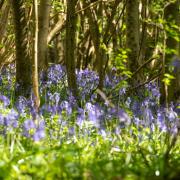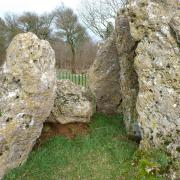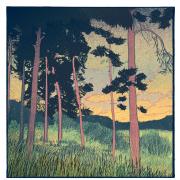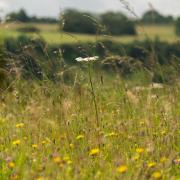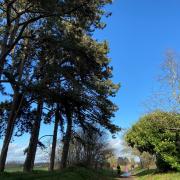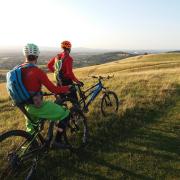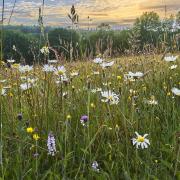Another year over? Already? Time for another New Year’s celebration! What do you do for New Year? Fireworks? Sing Auld Lang Syne? Climb Banbury Cross? Drink champagne at midnight … or all night long? This month we’re exploring traditional New Year’s customs in the Cotswolds and beyond

These last few years have whisked by with alarming speed and, I don’t know about you, but 2023 sounds like we’re in the space age! However, at New Year, we spend as much time looking back as we do looking forward. It’s a time for New Year’s resolutions (I always resolve not to do them!) but also taking stock of the year that’s just gone. The very name of the month suggests this tension – from Janus, Roman god of beginnings and endings – and of doorways, very important at New Year.
In Gloucestershire and Warwickshire the first person to enter the house in the New Year was significant. As with northern British ‘first footing’, the identity of the person was key to ensuring the good luck they brought: it should be a man and, from Minchinhampton to Birmingham, he should be dark-haired. In Wiltshire he carried a coal – perhaps a tradition brought by the railways to a non-coal-mining area? In Charlton Kings until the 1930s, however, the tradition was slightly different, since the first in the house was the ‘boy visitor’, who too had to be dark, but had to go into the house by the back door and leave by the front – going in using a ladder and a window if there was no back door! These strangers – and it was important they weren’t known to the household – got a silver coin for their pains. Woe betide, though, if anyone spoke to the boy visitor or the coin wasn’t silver, since all the good luck that he’d brought would then come to nothing! Gwilym Davies says the boy went the other way, in the front door and out the back, up till the 1960s. Perhaps the tradition changed, as traditions will.
In Upton St Leonards, Gotherington, Woolstone, children would go around the houses on New Year’s Day morning with baskets, singing:
Blow well and bud well and bear well,
God send send you fare well.
Every sprig and every spray,
A bushel of apples to be given away
On New Year’s Day in the morning.
Gifts of apples – of course – and cakes would be given to the children. This ‘bud-welling’, as it was known in Charlton Kings, may well be linked to the old custom of wassailing the apple trees on Twelfth Night, but all these customs are linked to bringing luck into the house and to the all-important harvest.


In and around St Briavels, there was a rather different custom. There the old Welsh tradition of the ‘calennig’ – or ‘calend egg’ in the Forest – was kept up until about the 1950s. In Wales, the going out on New Year’s Day for a gift was the meaning of ‘calennig’, but when it slipped over the border the word got attached to the thing the children carried around – an apple on a tripod of three twigs, pierced with nuts or seeds and topped with herbs. The fruit, seeds, and herbs were said to represent the gifts of the Three Wise Men – sweetness, wealth, and immortality. The children took these calend eggs with them as they perambulated the local houses to solicit gifts of bread, cheese, and maybe a little money. Customs like these remind us that winter house-visiting was a way to help those in need at what was a difficult time of year in times without benefits, pensions, or other state support – and the song sung in parts of Wales reminded you to be generous because ‘before the next arrival of the new year many will be dead …’

Further north in the Forest district, something much more dramatic takes place at the next celebration, Twelfth Night, the very end of the Christmas season. In Pauntley, on each of the farms where wheat was grown, the farmer and his workers would head out in the cold to a wheat field and there light twelve small fires and a big one. The twelve fires were said to be for the twelve apostles and the big one, of course, was for Jesus. One of the fires would be stamped out early – for Judas Iscariot, the betrayer. When that was done, the farmworkers would study the fires and make cider-fuelled predictions about the harvest according to how each fire had burned.
Then all would gather round the large fire and raise a toast or three of cider to the master and to wish success to the future harvest. The halloos from the men would ring out into the night and be answered from the neighbouring farms. In the 18th century, in Herefordshire at least, on returning to the cowsheds a further ceremony would take place. A large carraway seed cake baked with a hole in the centre, and soaked in cider, would be placed on the horn of the lead ox. He would be tickled until he tossed his head and, if the cake fell backwards, the mistress of the farm got the cake, and if forwards, the master of the oxen had the prize. Then all would troop back to the farm, find it locked against them, and have to sing their way inside.

This custom was so widespread in north Gloucestershire and Herefordshire that it’s said you could see 50 or 60 fires on different farms at once. In Pauntley, with the encouragement of the rector, the tradition was revived in 2006 in a field behind the church – right next door to the house where Dick Whittington is said to have been born. Up until the pandemic, at least, the fires burned again to wish good luck to the crops and to celebrate the lives of the apostles.
Cakes were important, particularly mince pies – known as ‘God cakes’ in Coventry – and it was said that if you ate a mince pie every day of the 12 days of Christmas then good luck would come to you in each of the 12 months of the year! There are some provisos, though: in Wiltshire it’s said that you needed to be given each one from a different friend and that if you spoke while eating the pie then all the good luck would disappear. Didn’t manage it this year? Well, don’t worry – because 2024 will be around before you know it!

ESSENTIALS
Places: Charlton Kings, St Briavels, Pauntley.
Further reading: Gloucestershire Folk Tales for Children by Anthony Nanson and Kirsty Hartsiotis; Stations of the Sun by Ronald Hutton; The English Year by Steve Roud.
LINKS
The calennig in Wales, Herefordshire, and the Forest of Dean: bit.ly/3iNHaOy
The revival of the Pauntley Judas Fires: viewfromthepew.co.uk/march-2012
Kirsty Hartsiotis is based in Stroud and available for hire as a storyteller and speaker. She is an accredited Arts Society lecturer. Her books include Wiltshire Folk Tales and (with Anthony Nanson) Gloucestershire Ghost Tales and Gloucestershire Folk Tales for Children. She is also the curator of decorative art at a Gloucestershire museum.
-------------
TAKE A WALK WITH YOUR PHONE

THE SLAUGHTERS
Start: Bourton-on-the-Water
Distance: 4.5 miles (7.2km)
Time approx.: 2.5 hours
Parking: Rissington Road Pay & Display
Recommended direction is clockwise.

This walk visits the villages of Upper and Lower Slaughter – classic examples of charming Cotswold villages, with mellow stone houses nestled on the River Eye.
Beginning in the tourist hotspot of Bourton-on-the-Water, you quickly leave behind the busy main street and head into open countryside along the banks of the River Windrush, turning right towards Upper Slaughter. Pass through the centre of the village and turn to follow the River Eye to Lower Slaughter. Here you will find ice cream (on warmer days!) and refreshments at the Old Mill. After taking advantage of the photo opportunities, it is a short walk back to Bourton-on-the-Water where you will find a significant collection of eateries and tourist shops.
Download the Cotswold Walks app and let your mobile guide you around the route. It shows your location on the map as you walk, and even works without a phone signal.
To dowload the app, search ‘Cotswold Walks’ on the iPhone or Google Play AppStore. For more information visit: pathranger.com/cotswoldwalks






